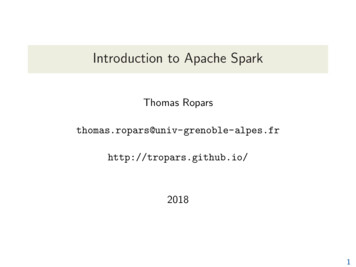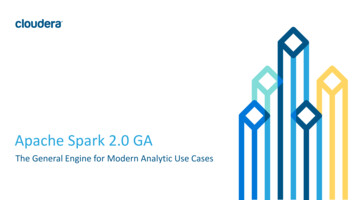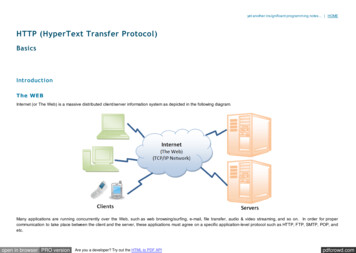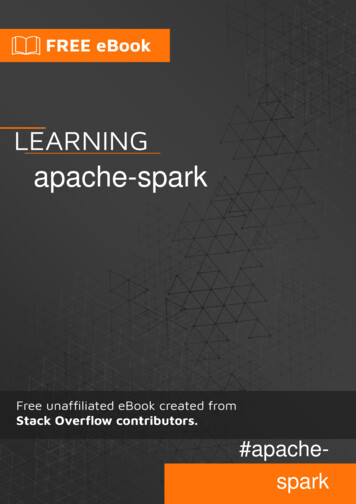
Transcription
Is Apache Spark Scalable to Seismic Data Analyticsand Computations?Yuzhong Yan, Lei HuangLiqi YiDepartment of Computer SciencePrairie View A&M UniversityPrairie View, TXEmail: yyan@student.pvamu.edu, lhuang@pvamu.eduIntel Corporation2111 NE 25th Ave.Hillsboro, OREmail: liqi.yi@intel.comAbstract—High Performance Computing (HPC) has been adominated technology used in seismic data processing at thepetroleum industry. However, with the increasing data size andvarieties, traditional HPC focusing on computation meets newchallenges. Researchers are looking for new computing platformswith a balance of both performance and productivity, as well asfeatured with big data analytics capability. Apache Spark is a newbig data analytics platform that supports more than map/reduceparallel execution mode with good scalability and fault tolerance.In this paper, we try to answer the question that if ApacheSpark is scalable to process seismic data with its in-memorycomputation and data locality features. We use a few typicalseismic data processing algorithms to study the performance andproductivity. Our contributions include customized seismic datadistributions in Spark, extraction of commonly used templatesfor seismic data processing algorithms, and performance analysisof several typical seismic processing algorithms.Index Terms—Parallel Computing; Big Data Analytics; SeismicData; Stencil Computing;I. I NTRODUCTIONPetroleum is a traditional industry where massive seismicdata sets are acquired for exploration using land-based ormarine surveys. Huge amount of seismic data has already beengenerated and processed for several decades in the industry,although there was no the big data concept at that time. HighPerformance Computing (HPC) has been heavily used in theindustry to process the pre-stack seismic data in order to create3D seismic property volumes for interpretation.The emerging challenges in petroleum domain are theburst increase of the volume size of acquired data and highspeed streaming data from sensors in wells that need to beanalyzed on time. For instance, the volume size of highdimension such as 3D/4D seismic data and high densityseismic data are growing exponentially. The seismic dataprocessing becomes both computation- and data- intensiveapplications. The traditional HPC programming model is goodat handling computation-intensive applications, however, withthe continuously increasing sizes and varieties of petroleumdata, HPC was not designed to handle the emerging big dataproblems. Moreover, HPC platforms has been an obstacle formost geophysicists to implement their algorithms on suchplatforms directly, who demand a productive and scalableplatform to accelerate their innovations.In many the data- and technology-driven industries, bigdata analytics platforms and cloud computing technologieshave made great progress in recent years toward meetingthe requirements of handling fast-growing data volumes andvarieties. Hadoop [1] and Spark [2] are currently the mostpopular open source big data platforms that provide scalablesolutions to store and process big data, which deliver dynamic,elastic and scalable data storage and analytics solutions totackle the challenges in the big data era. These platforms allowdata scientists to explore massive datasets and extract valuableinformation with scalable performance. Many technologiesadvances in statistics, machine learning, NoSQL database,and in-memory computing from both industry and academiacontinue to stimulate new innovations in the data analyticsfield.Geophysicists need an ease-to-use and scalable platformthat allows them incorporate the latest big data analyticstechnology with the geoscience domain knowledge to speedup their innovations in the exploration phase. Although thereare some big data analytics platforms available in the market,they are not widely deployed in the petroleum industry sincethere is a big gap between these platforms and the specialneeds of the industry. For example, the seismic data formatsare not supported by any of these platforms, and the machinelearning algorithms need to be integrated with geology andgeophysics knowledge to make the findings meaningful.Are these big data analytics platforms suitable in thepetroleum industry? Because of lack of domain knowledge,these platforms have been difficult to use in some traditionalindustry sectors such as petroleum, energy, security, andothers. They need to be integrated and customized to meetthe specific requirements of these traditional industry sectors.The paper targets to discuss the gap between the generalfunctionality of the big data analytics platforms and the specialrequirements from the petroleum industry, and to experiment aprototype of Seismic Analytics Cloud platform (SAC for short)[3, 4]. The goal of SAC is to deliver a scalable and productivecloud Platform as a Service (PaaS) to seismic data analyticsresearchers and developers. SAC has two main characteristics:one is its scalability to process big seismic data, and the otheris its ease-to-use feature for geophysicists. In this paper, wedescribe our implementation of SAC, experiment with a few
typical algorithms in seismic data analytics and computations,and discuss the performance in details.II. R ELATED W ORKThe big data problem requires a reliable and scalable clustercomputing or cloud computing support, which has been alongstanding challenge to scientists and software developers.Traditional High Performance Computing (HPC) researcheshave put significant efforts in parallel programming models including MPI [5], OpenMP [6], and PGAS languages [7, 8, 9],compiler parallelization and optimizations, runtime support,performance analysis, auto-tuning, debugging, scheduling andmore. However, these efforts mostly focused on scientificcomputing, which are computation-intensive, while big dataproblems have both computation- and data-intensive challenges. Hence, these traditional HPC programming modelsare not suitable to big data problems anymore. Besidesscalable performance, tackling big data problems requires afault-tolerant framework with high-level programming models,highly scalable I/O or database, and batch, interactive andstreaming tasks support for data analytics.MapReduce [10] is one of the major innovations that createda high-level, fault-tolerant and scalable parallel programmingframework to support big data processing. The Hadoop [1]package encloses Hadoop Distributed File System (HDFS),MapReduce parallel processing framework, job schedulingand resource management (YARN), and a list of data query,processing, analysis and management systems to create abig data processing ecosystem. Hadoop Ecosystem is fastgrowing to provide an innovative big data framework for bigdata storage, processing, query and analysis. Seismic Hadoop[11] combines Seismic Unix [12] with Cloudera’s Distributionincluding Apache Hadoop to make it easy to execute commonseismic data processing tasks on a Hadoop cluster. In [13],[14] and [15], some traditional signal processing and migrationalgorithms are already implemented on MapReduce platform.[16] built a large-scale multimedia data mining platform byusing MapReduce framework, where the processing dataset issimilar to seismic image. However, MapReduce only supportsbatch processing and relies on HDFS for data distribution andsynchronization, which has significant overloads for iterativealgorithms. Furthermore, there is no support for streamingand interactive processing in MapReduce, which becomesthe biggest hole for supporting time-sensitive data processingapplications.To reduce the overhead of shuffling data into HDFS andto support more widely used iterative algorithms, there raisedseveral in-memory computing frameworks. Apache Flink [17]is a fast and reliable large-scale data processing engine, whichis originally coming from Stratosphere [18]. It provides inmemory data sets, query language, machine learning algorithms and interfaces handling streaming data. Besides providing batch processing function, Flink is good at incrementaliterations by pipelining data in an execution engine, whichmakes it suitable for most machine learning algorithms. Spark[19] is a quick-rising star in big data processing systems,which combines the batch, interactive and streaming processing models into a single computing engine. It providesa highly scalable, memory-efficient, in-memory computing,real-time streaming-capable big data processing engine forhigh-volume, high-velocity and high-variety data. Moreover, itsupports high-level language Scala that combines both objectoriented programming and functional programming into a single programming language. The innovative designed ResilientDistributed Dataset (RDD) [20] and its parallel operationsprovide a scalable and extensible internal data structure toenable in-memory computing and fault tolerance. There is avery active, and fast-growing research and industry communitythat builds their big data analytics projects on top of Spark.However, all these frameworks are built for general proposecases and are focused on data parallelism with improvedMapReduce model, and there is no communication mechanismbetween workers, which does not fit to some iterative seismic algorithms requiring frequent data communication amongworkers. Both traditional seismic data storage and processingalgorithms need big changes to run on MapReduce platform.With the growing exponentially of the seismic data volumes,how to store and manage the seismic data becomes a verychallenge problem. The HPC applications need to distributedata to every worker node, which will consume more timeon data transferring. The trend toward big data is leadingto transitions in the computing paradigm, and in particularto the notion of moving computation to data, also callednear-data-processing(NDP) [21]. In Data Parallel System suchMapReduce [22], clusters are built with commodity hardwareand each node takes the roles of both computation and storage,which makes it possible to bring computation to data. In[23], it presented an optimized implementation of RTM byexperiments with different data partitioning, keeping datalocality, and reducing data movement. In [24], it proposed aremote visualization solution by introducing GPU computinginto cluster, which could overcome problems of dataset size byreducing data movements to local desktop. In [25], it evaluatedthe suitability of MapReduce framework to implement largescale visualization techniques by combining data manipulation and data visualization system on cluster. Besides binaryseismic data, there are huge amount semi-structured data andmetadata generated at seismic data acquisition and processing.There are some obvious limitations of traditional RDBMS tohandle this kind of big data; RDBMS is not flexible to handledifferent types of data, and there are also scalability and performance limitations on RDBMS. The NoSQL database[26]is designed to be more suitable in such a scenario. Cassandra[27] is a distributed NoSQL database designed to handlelarge amount of data that could achieve linear scalabilityand fault-tolerant ability without compromising performance.MongoDB [28] is a document-oriented NoSQL database thatcasts focus on flexible data model and highly scalability. Redis[29] is a data structure server that provides key-value cacheand storage, and it works with in-memory dataset thus couldachieve outstanding performance. Based on the characteristicsof seismic data, Cassandra could be used to store intermediate
data shared by all workers.With the increasing volume size of seismic data, the algorithms applied on data also become more sophisticated toextract valuable information. Some advanced machine learningalgorithms are already used in this area. [30] used artificialneural network (ANN) to predict sand fraction from learningmultiple seismic attributes such as seismic impedance, amplitude and frequency. In [31], it set up a model by feedingfive seismic attributes and the reservoir thickness to trainSupport Vector Machines (SVM) and then used it to predictthe reservoir thickness. [32] used meta-attributes to train multilayer neural networks and evaluated the effectiveness of thenew generated seismic fault attribute. [33] used Back Propagation Neural Network (BPNN) for the automatic detectionand identification of local and regional seismic P-Waves.Petuum [34] is a distributed machine learning framework thatis focused on running generic machine learning algorithms onbig data sets and simplifying the distributed implementationof programs. Based on characteristics of machine learning algorithms, Petuum provides iterative-convergent solutions thatquickly minimize the loss function in a large-scale distributedcluster. Since these frameworks such as Petuum and Graphlab[35] are designed specially for machine learning algorithms,they could get better performance comparing with other general purpose MapReduce frameworks that emphasize on consistency, reliability and fault tolerance, but their programmingmodels are not easy to use comparing with MapReduce.In summary, although there are already many researchprojects trying to solve the big data problem, there is still nosolution designed specific to seismic data. The MapReduceplatform and its predecessors are too common to supportcomplicated seismic algorithms, while some other platformseither emphasize on performance of computation or modeloptimization in narrow specific area. To make it easy forgeophysicists and data scientists processing and analyzing bigpetroleum data, a new platform is needed by incorporatingthe advances of big data research into the industry. Sucha platform should not only be capable of processing bigdata efficiently and running advanced analytics algorithms,but also should achieve fault tolerance, good scalability andusability. Seismic data management and distribution need tobe implemented in order to allow geophysicists to utilize theplatform. Moreover, the common-used seismic computationtemplates and workflow would be very useful to simplify theirwork.which includes JRE/JDK, Scala, Python and other nativelibraries such as OpenCV [36], FFTW [37] etc. In the thirdlayer, there are some common components installed includingHDFS, Mesos [38] and YARN [1] used for the data storageand resource scheduling. HDFS is a distributed file systemdelivered in Hadoop that provides fault-tolerance and highthroughput access to big data sets. In SAC, HDFS is used forstoring original binary seismic data. The metadata and intermediate data such as seismic attributes are stored in Cassandradatabase. Resource management in cluster is very importantfor application scheduling and load balance, and in SAC,Standalone, Mesos and YARN are all supported. In the fourthlayer from bottom, it includes the actual computation components: signal and image processing libraries with Java/Scalainterfaces; Breeze [39] is a set of libraries for machine learningand numerical computing written in Scala and Java. FFTWis a C subroutine library for computing the Discrete FourierTransform (DFT) with one or more dimensions in both realand complex data format. There are already some Java FFTWwrappers make it could be used on JVM without giving upperformance. SAC chose Spark as the computation platformdue to its performance achieved with in-memory computationand its fault tolerance features. The main work of this paperis focus on the second and third layer from top. SeismicAnalytics Cloud layer is used for providing SDK and runningenvironment for client applications. SAC Framework plays themost important role in this cloud platform, and it is the bridgeof user’s applications and running environment on cluster. Thetemplate-Based framework provides common programmingmodels for domain specific experts, and the workflow framework connects pieces of algorithms or models into job chains,and run them following the workflow sequence. Visualizationis important for user to view results and to generate usefulinformation intuitively. Seismic Applications on the top ofstack are mainly developed by end users. There is an userfriendly web interface provided by SAC, on which users couldview datasets, programming and testing algorithms or runningworkflow in a convenient way by drag-and-drop of widgets.III. I MPLEMENTATIONSAC is built on Spark to boost performance by utilizingin-memory computing model. In order to make it easy to useby geophysicists, we developed some high level seismic dataprocessing templates to facilitate the user programming efforts.Figure 1 shows the overall software stack used in SAC.In this diagram, the operating systems at the first level frombottom could be Unix-like or Windows system running on thevirtual machines or bare metals. Above the OS layer, thereis a layer that provides compiling and running environment,Fig. 1: The Software Stack of Seismic Analytics Cloud Platform
A. Seismic RDDResilient Distributed Datasets (RDDs) [20] is core conceptproposed by Spark, which is a fault-tolerant collection ofelements that can be operated in parallel. RDDs [40] supporttwo types of operations: transformations, which create a newdataset from the existing one, and actions, which return a valueto the driver program after running the defined computationon the dataset. Even in parallel programming on cluster, theprogram still consists of data structure and algorithms. Sparkuses the RDD as a common data structure that distributed inmulti-nodes, and provides some typical operations as algorithm frameworks in functional language style so that the usercould plug in his own algorithms and apply them on RDD.Comparing with traditional parallel programming models suchas MPI and OpenMP, the programming on Spark is muchsimpler. But for geophysicists or data scientists who haveno much idea about RDD and functional language, there arestill some tedious jobs to do. SAC tried to simplify workby introducing Seismic RDD and Template. Users only needto configure some parameters: the dataset need to process,input and output type of algorithms, then write a piece ofcodes, after that SAC will generate Seismic RDD, createthe template, merge user’s codes and run them automatically.Seismic RDD is built from SeismicInputFormat, and besidesthe basic operations provided by Spark, Seismic RDD alsoprovides some other features: the fine-grain functions on pixelor trace inside each split, transferring RDD from defaultinline direction to other directions automatically basing onconfiguration, overiding some operators for easily used byhigh level applications. The most advantage of the RDD iscaching most frequently used data in memory, thus improvingperformance of some iteration algorithms drastically.as input and one line or more lines as output; SubVolumepattern, which feeds user’s application with a sub-volume andget output from it in sub-volume format. These templates couldhandle most cases with one seismic data set, but it couldnot handle other cases with two or more seismic data setsas input because map/flatMap functions can only be appliedon one RDD. For the case with two RDDs, we can merge theminto one RDD with zip function, and then apply map/flatMapfunctions on the combined RDD.Beside these transformations, there are still some othersummary operations or actions in Spark such as count, statsor collect etc. Those functions have no definite templates, butare very useful. So SAC provides a free-style template bypassing RDD directly to user’s application, on which userscould call any transformations and actions as required. Forsome sophisticated models that are difficult to split into subtasks or have multiform of input or output, free-style templateis also effective.B. Seismic Data Computation TemplatesEssentially, seismic data is a 2D plane or 3D volumecomposed by traces. The data type of trace data is Float typein IEEE floating-point format or IBM floating-point format.Classical signal processing or image processing algorithmshave been widely used for processing seismic data. The grainsize of input/output data could be sample point, trace, 2D planeor 3D volume. The relationship between volume size of inputand the other one of output is shown in Figure 2, in which solidcircle (input data) or hollow circle (output) indicates one point,one trace, one plane or even one volume. The relationshipcould be 1 to 1 (Figure 2 a), N to 1 (Figure 2 b) or 1 toN (Figure 2 c). In some case such as median filter, there isoverlap between each input split, which could be treated asa special case of 1 to 1, but the overlap edges need to beconsidered in data distribution. After study of the popular opensource seismic data processing packages, signal processing andimage processing packages such as SU, Madagascar, JTK [41],Breeze, OpenCV, ImageMagick etc., we define some typicaltemplates in SAC: Pixel pattern, which uses the sub-volume orone pixel as input and output one pixel; Trace Pattern, whichuses one trace or several traces as input and output one ormore traces; Line pattern, which treats one line or more linesFig. 2: Relationship of Input and Output in Seismic DataProcessingIV. E XPERIMENTSTo evaluate the performance of SAC, we setup the experiment environment, develop the SAC framework and runsome typical seismic applications on SAC. There are threemain layers in SAC: the low-level runtime environment, SACframework as the middleware and application development interfaces at up-level. The middleware layer of SAC was alreadydiscussed in the pervious section. The runtime environment isthe base that SAC builds on, and the application developmentinterfaces serve as the entry for users. We chose three typicalseismic volume computation algorithms: Fourier Transform,Hilbert Transform, and Jacobi stencil computations as ourexperiments.The cluster used for conducting experiments consists of25 nodes, in which one is the management node and other24 nodes are computation nodes. Each node in this cluster
was equipped with Intel Xeon E5-2640 Sandy Bridge CPU(2.5GHz, 12 Cores or 24 Cores with Hyper-threading support),64GB DDR3 memory and all nodes are inter-connected with1GB ethernet. Each node has its own local disk, and also couldaccess disk array through NFS. Following the architecturestated in previous section, we install CentOS 6.5 (Distributedby Redhat) and Oracle JDK 1.8.0 40 on each node. Hadoop2.2.0, Spark 1.2.1 and other related libraries are also installedon each node. In the configuration of HDFS, the managementnode was configured as NameNode and other 24 computationnodes as DataNodes. It is similar in Spark: the managementnode is Master and other computation nodes are Workers.Cassandra was installed on all 24 computation nodes and thefirst four nodes of them were selected as seed nodes.The public sample seismic dataset Penobscot [42] wasselected as experiment data. The original format of Penobscotdataset is SEGY, and to make it easily processed with Spark,we transfer it into two files: one xml file that saves metadata, and another binary data file with dimension size of600x481x1501 stores actual 3D data samples. The volumesize of the original data file is about 1.7GB, which is notbig enough comparing with datasets currently used in oil &gas industry, so we use it synthesize a new 100GB file forverifying algorithms and models on SAC. For some extensivetime consuming algorithms, we still use the 1.7GB binary fileas test data. Both of xml file and data file are stored on HDFS,so that every node could access them and utilize data locality.The intermediate results are stored in Cassandra basing onrequirement and final results are persisted back to HDFS.A. Fourier & Hilbert TransformationIn the signal and image processing area, Fourier transform(FT) is the most commonly used algorithm. The signal intime domain was decomposed into a series of frequenciesthrough FT, and in the frequency domain, many problems suchas filters are easier to perform comparing with in the timedomain. Fast Fourier transform (FFT) [43] is an algorithm tocompute the discrete Fourier transform (DFT) and its inverseby factorizing the DFT matrix into a product of sparse (mostlyzero) factors. There are different implementations of FFT,such as FFTW, OpenCV, Kiss FFT, Breeze etc. FFTW[44]emphasizes performance by adapting to the hardware suchas SIMD instructions in order to maximize performance,while Breeze aims to be generic, clean and powerful withoutsacrificing (much) efficiency. Breeze provides more conciseinterfaces of 1D/2D Fourier transforms and filtering functions,so we use FFT function in Breeze as the test case by applyingit both in sequential codes and parallel codes running on Spark.The Hilbert transform [45] is important in the field of signalprocessing where it is used to derive the analytic representationof a signal. A great number of geophysical applicationsconsist in close relation of the Hilbert transform to analyticfunctions of complex variable [46]. Hilbert transform approachnow forms the basis by which almost all amplitude, phaseand frequency attributes are calculated by today’s seismicinterpretation software [47]. JTK already provided the Hilberttransform filter class, so we use it as the test case by applyHilbert transform filter on each trace of input seismic data set.B. Jacobi Stencil ComputationStencil operations are the most common computations usedin seismic data processing and reservoir simulation in oil &gas industry, and most of codes in this domain were writtenin MPI or OpenMP programming models running on largescale clusters or large-scale SMP. MPI codes typically involvecomplicated communications with significant programming efforts and could not handle fault tolerance very well. AlthoughOpenMP makes it easy to parallelize sequential codes onSMP, with increasing size of volume of seismic data, SMPencounters the problem of caching large data volume andscalable performance issue.We choose Scala as the programming language for experiments and develop four applications for Jacobi stencil computation: Sequential codes, Parallel codes using broadcastingvariable, Parallel codes using Cassandra database and Parallelcodes with boundary RDD, in which sequential codes run onsingle core and parallel codes in Spark run on the wholecluster. For the Sequential codes, we just split the big datafile into small partitions and each partition includes severalinlines, then use 3 nested loops to compute average value of26 (3x3x3 sub-volume) neighbor samples. After computation,results of each partition will be saved into the temporaryfile to be used as input of next iteration. For the Parallelcodes with broadcasting variable, the large input dataset isdistributed to all active nodes in the whole cluster as RDD,then each node could get its own data section and applymap function (computation part) on it. Since the boundarydata is need for Jacobi kernel and there is no communicationinterfaces between mappers, the boundary planes of each splitare collected as a big variable and broadcasted to all nodes bydriver node after one iteration, then each node could fetchnew boundary Inlines in next iterative computation. Afterimplementation of Parallel codes using broadcasting variable,we found the performance of collecting data is very bad, so wedesign new Parallel codes using Cassandra DB and boundaryRDDs to exchange boundary data and to avoid collecting datain each iteration.The data flow of parallel methods (broadcast variables andboundary RDD) are shown in Figure 3: each number denotesone plane of seismic data. The big seismic data file is storedon HDFS, which will be divided into small partitions and sendto each worker node by driver node. Using broadcast variablesshown in top half of diagram, the driver node needs to collectboundary planes from every node, which will take more timeon network communication. The solution of using boundaryRDDs is shown in below half diagram, in which boundaryRDDs are filtered from result RDD, but they need repartitionand resort for alignment and then merge with original RDDto form a new RDD for next iteration. In the programmerview of sharing data, sharing with Cassandra database issimilar to broadcast variables of Spark, but the underline datacommunication is distinct.
Fig. 3: Data Flow of Jacobi Parallel Codesdata from network, and the big fluctuations related with systemtime came along with significant longer GC pauses. Figure 6shows the same data running with 30 lines per split and 288cores, in CPU usage of which there are 4 peak bands that mean4 sub-tasks and there is one valley at the end where the entirejob is finalizing and waiting for stragglers. Figure 7 showsresource usage on another node, on which 5 tasks have beenrun. In the case of 30 lines per split, each sub-task will takemore time and not all nodes get same number of sub-tasks torun, so there are some nodes need to wait all tasks finishedat end. The utilization of CPU is better in 10 lines per split,so with same resources, performance of 10 lines per split isbetter than the one of 30 lines per split.V. P ERFORMANCE D ISCUSSIONThere are a lot of tools used for measuring performance ofthe application running on single node or on cluster. In order tomake some deep analysis to find the performance bottleneck,we used several performance tools to collect the detailedperformance metrics such as CPU usage, memory usage, diskI/O and network communication. Spark itself provides an webUI for monitoring of resource usage of the whole cluster, taskrunning status and detail information of each stage in task,which emphasizes more on application profile and executiontime. Ganglia [48] is a scalable distributed monitoring systemfor high-performance computing systems such as clusters andGrids, which is focus on utilization of resources on the cluster.Nigel’s performance Monitor (nmon) could collect miscellaneous metrics information on each node, and NMONVisualizercould visualize
featured with big data analytics capability. Apache Spark is a new big data analytics platform that supports more than map/reduce parallel execution mode with good scalability and fault tolerance. In this paper, we try to answer the question that if Apache Spark is scalable to process seismic data with its in-memory










